Blame! is the debut series of Tsutomu Nihei, a science-fiction cyberpunk manga artist. He’s among the best and most talented manga artists out there and his art can compare to the best in the entire medium.
If you want to learn more about cyberpunk, check out this amazing article on cyberpunk by Atlas1!
Blame! is one of my favorite manga of all time. It’s unique, beautiful, awe-inspiring and at times brutal. The manga stands out for its amazing setting, the stunning action scenes, but also the many gorgeous and disturbing cybernetic horrors that populate it.
It tells a dark, futuristic story that depicts a world in which technology is running amok and has created one of the most unique settings ever created.
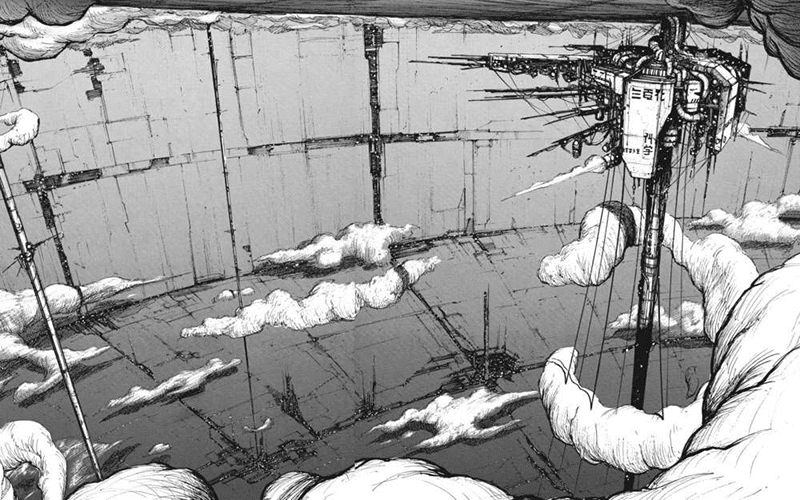
The world of Blame! is a typical cyberpunk setting, depicting a world of fascinating high-tech but at the same low-life for all its inhabitants. Many other cyberpunk tropes fit Blame! as well, but the manga also features many instances of biomechanics and bio-punk.
Tsutomu Nihei was an architecture student before he became a manga artist. This knowledge of architecture is one reason Blame! is so unique and impressive. We constantly see grand, awe-inspiring buildings and massive architectural wonders. Blame!’s world isn’t just huge, it’s immeasurable and mind-boggling gigantic.
Blame! – The Plot

The plot of Blame! is relatively simple. Killy, our main character, wanders the world of Blame! only known as the City in search of a human with Net Terminal Genes. A person like this could access the Netsphere, stop the chaotic growth of the City and stop the Safeguard from destroying what remains of humanity.
Over the course of the manga, we follow Killy on his journey through the world of Blame! and witness his interaction with the many other inhabitants of the City.
Blame! – The Setting
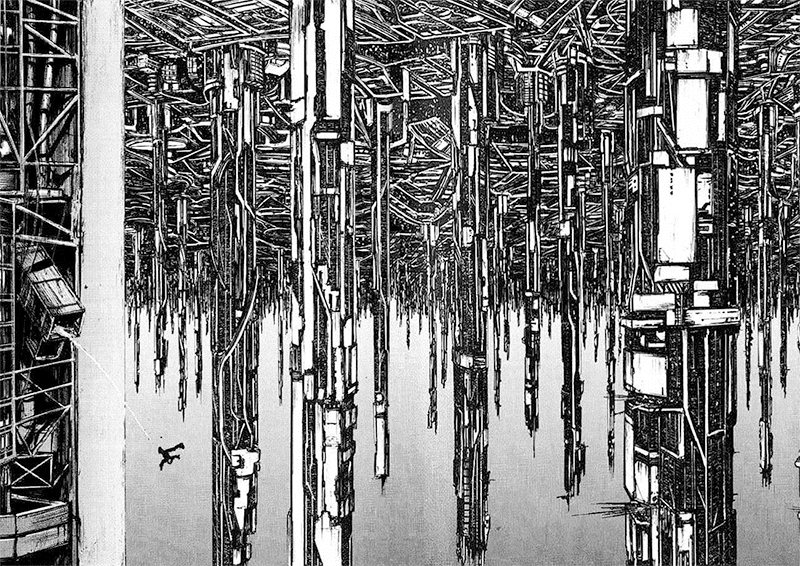
Blame’s world is dark and beautiful, chaotic and depressing and dangerous and brutal. It’s a wondrous, technological wasteland.
Blame! is a cyberpunk manga set in the far-future, but it’s also set in a post-apocalyptic dystopia.
The apocalyptic event was the loss of control over the City and thus over the builders and the Safeguard. There’s also the infection and devolution of humans and at the time of the story, no one with Net Terminal Genes remains.
The dystopian elements are clear at first sight. The surviving humans don’t amount to much when compared to the other cybernetic horrors inhabiting the City. They huddle together in small pockets of society and constantly have to fend for survival. Another aspect is the Netsphere, an advanced virtual reality which allows people to upload their consciousness. People with the Net Terminal Gene already did so, leaving the real world or base reality, as it’s called in Blame! behind.
The City

Blame!’s setting is entirely unique. It’s a world devoid of any natural elements. There are no forests, no normal ground and no mountains within the megastructures. Instead, everything we see in Blame! are buildings and constructions, many of which are of mind-boggling size. The City is a chaotic amalgamation of titanic architecture whose dimensions are entirely unknown to any of its dwellers. It’s essentially labyrinthine, futuristic dungeon.
Over the course of the manga, we learn more about the insane size of the City. At one point, Killy stumbles upon a single room the size of Jupiter inside the City. In the prequel NOiSE, we learn the Moon was the first celestial body incorporated into the City. It’s stated by the writer Tsutomu Nihei that the City is the size of a Dyson Sphere, meaning it stretches as far as the orbit of Jupiter.
Even now, however, the City continues to grow and is endlessly constructed by so called builders, autonomous robots. Since no human is possible to access the Netsphere, no one can communicate with the builders and so they just keep on increasing the size of the City.
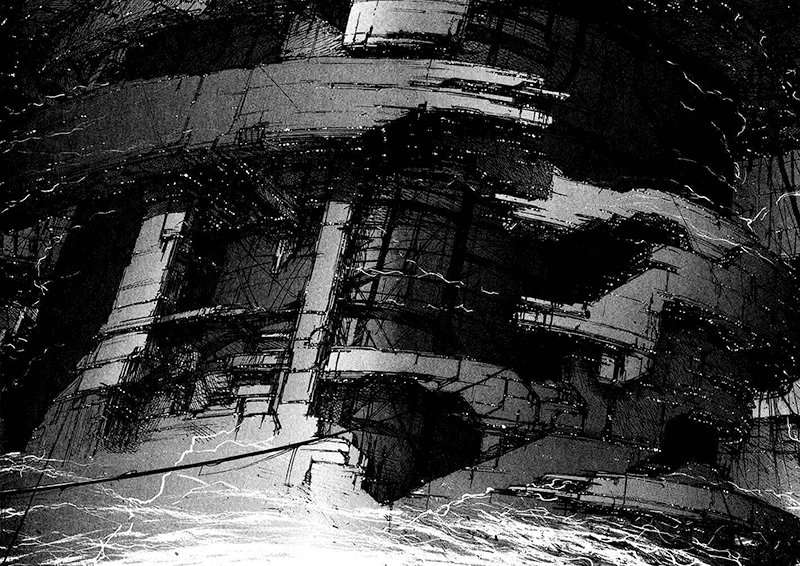
There are, however, some interesting details and concerns about the City. It’s so massive that its sheer size defies the law of physics. A construction the size of a Dyson Sphere would inevitably collapse into itself. Yet, this seems to be solved by certain gravitational controllers inside the megastructure which manipulate gravity itself and keep the City from destruction.
Another interesting tidbit is the sheer amount of materials. We learn, over the course of the story, that many celestial bodies have been harvested as raw materials. Even then, there wouldn’t be enough raw materials for a construction the size of the City. It’s implied, however, that builders can convert energy into matter, are using some sort of antimatter or can simply conjure matter into existence.
The City is one of the most unique and interesting settings I’ve ever come upon in manga.
The City’s Inhabitants
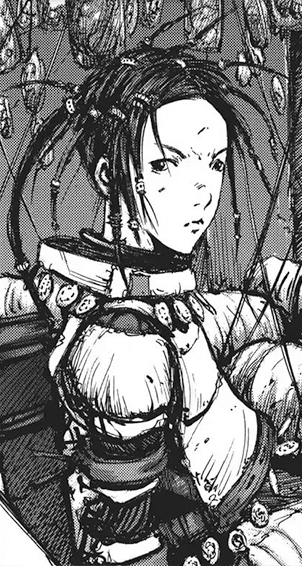
As mentioned before, humans don’t have it easy in the City. Many of them have to fight for survival and do so in various outposts and pockets of civilization. Some are smaller, others, however, like the Capitol, are bigger.
Many of the humans our main characters encounter look different from one another. Some are taller, others are smaller. The reason for this is most likely because of the often mentioned infection, devolution, and mutation. What they all have in common, however, is that they look pale, emaciated, even sick. These changes are also the reason that people aren’t carrying the Net Terminal Genes anymore.
The Safeguard was originally a security system to protect the Netsphere from unauthorized access and protect humans with the Net Terminal Gene. The Safeguard still follows these instructions, but by now hunts down and kills anyone without Net Terminal Genes.
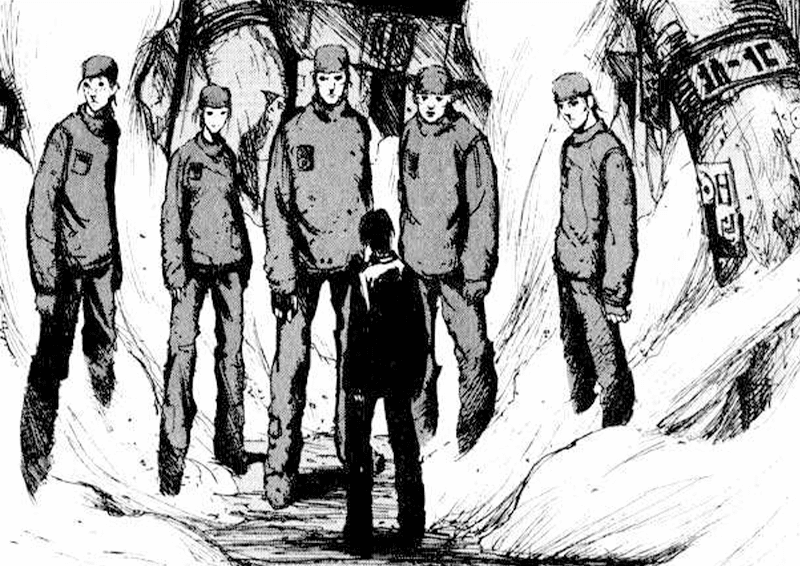
Other dwellers of the City are the Silicon Life, cyborgs who have their own goals, are independent from the Netsphere and want to keep the chaotic growth of the City going. If humanity would regain control over the City, and thus the Safeguard, they’d most likely use them to destroy the Silicon Life. And thus they want to keep the current status quo intact.
The last important fiction is the Governing Agency, which is basically the AI administration in charge of protecting the Netsphere. They are the ones who task Killy with finding a human with Terminal Net Genes to stop the chaotic growth of the City.
Blame! – Story-telling Conventions
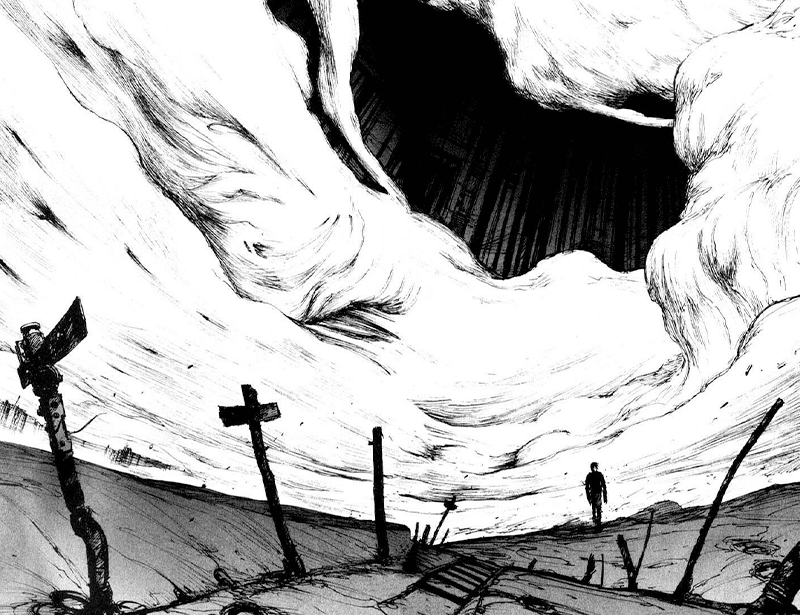
Blame! is a highly stylistic and unique manga, but that also means it’s not for everyone. The manga is mostly told via visuals and has very little dialogue.
Visual Story-telling

With Blame! Nihei pushes the entire manga towards the visual side and his story is told not by dialogues or conventional narration, but almost entirely by visuals.
Blame! is a grand example of virtual story-telling and of a work in which a setting drives the narrative. In Blame!, the narration is told via the setting and not the other way around.
It’s this reason that makes Blame! so special and unique because it succeeds at telling a story primarily through the art.
Many parts of Blame! comprise nothing but silence. We watch as Killy travels on through futuristic wastelands, desolation and massive derelict buildings.
There’s scarcely any dialogue in Blame! but often it’s unnecessary. A great example is Killy’s gun, the Gravitational Beam Emitter. Instead of telling us how it works and how powerful it is, Nihei shows us multiple panels of how destructive a single shot is. Another one is the City itself. We know it’s chaotically and continuously growing, but we’re never told how huge it is. Instead, Nihei conveys this entirely through the visuals. There are countless panels in which we’re shown a bird’s-eye view of Killy as he wanders through buildings and past constructions of mind-boggling proportions.
Another great way about Blame!’s specific way of story-telling is that the manga’s never bogged down by needless explanations. We don’t get long-winded explanations about how the world of Blame! works. Instead, we merely witness the stunning, bizarre and nightmarish effects of the technological wonders Nihei conjures. Blame! is all visual.
This visual story-telling also influences the pacing of the manga, which lends itself especially well to the many action-sequences of the manga.
World-building
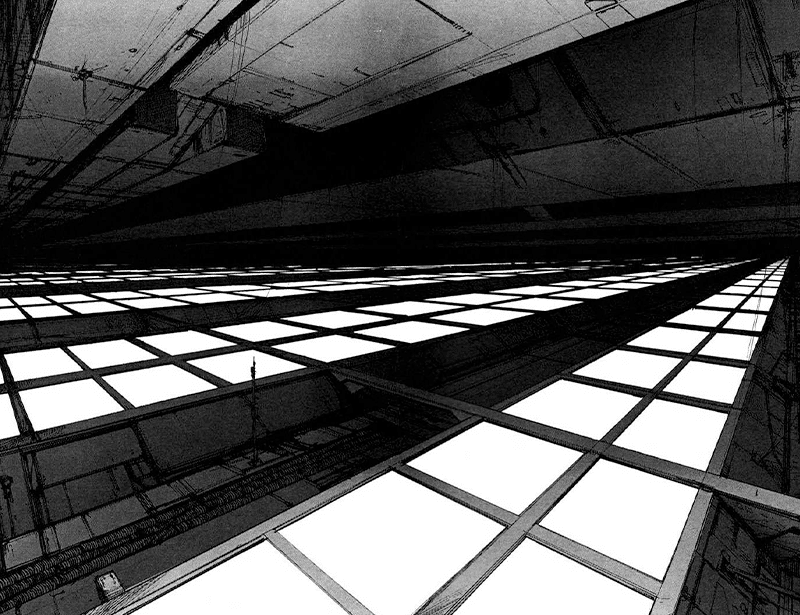
Nihei’s fantastic at world-building and Blame!’s a masterclass in world-building.
We know right from the very first chapter that Blame!’s a world that’s unfamiliar, dangerous and even alien when compared to our own. As we watch Killy’s travels, we soon realize that the City is entirely different from our world and it gives us a feeling of alienation.
All this is only possible by the insane, futuristic technology that exists within the City. This technology, however, is never explained, we just see it. Blame! happens so far in the future and everything can be explained by technology, but technology that not even the cast of characters truly understands anymore.
A lot of the technology we witness is the stuff of dreams or nightmares. This is most prevalent in the arc about Toha Heavy Industries. It’s here we learn that teleportation, time travel and even traveling to parallel realities is possible. All that, however, is hinted at to be caused by yet another of Nihei’s strange, futuristic technologies going haywire.
What’s true about technology is also true about the many factions and the mythology of the world. We only learn more about the City and its inhabitants in bits and pieces and have to put together the entire story on our own. All of it is vague, however, at times confusing, but it adds so much more to the mystery of the story and the atmosphere.
Characters
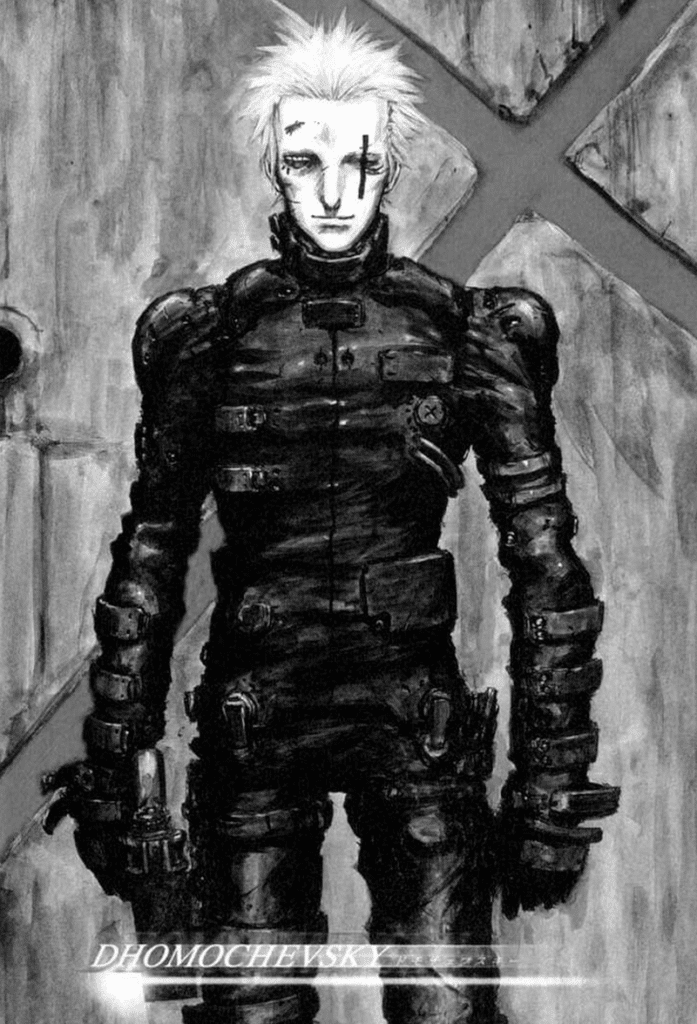
The main characters in Blame! are stoic, quiet badasses that almost never twitch when they get hurt.
This is truer for Killy than for everyone else. As he wanders the City he barely ever utters a word. That changes when he meets up and continues to travel with Cibo, but there’s still very little dialogue compared to other works.
When reading Blame! one soon learns that Killy isn’t a normal human being, and it’s later revealed or at least hinted at that Killy, similar to Dhomochevsky and Iko, is a provisional Safeguard. Even then, his past is hazy and we never learn much about him apart from what we witness of his mission.
Many of the human characters we encounter are badasses in their own right, and one can clearly see the toll survival has taken on them. We never encounter someone who’s truly happy or truly beautiful. No, this is a dark, depressing and dangerous world and it shows as much in its setting as in its characters.
The Story

While the manga comprises various arcs within their own specific parts of the megastructure, Killy’s overall quest ties it all together.
Because of the special way Blame! is told, the manga can be confusing. There’s little dialogue and no exposition.
This is especially the case at the beginning of the manga when we don’t know what’s going on. We merely follow Killy as he wanders the City through several almost unconnected chapters.
The story only gets more engaging when Killy reaches the Capitol and meets up with Cibo.
Even then, the reader has to always put things together on their own as information is revealed slowly and only bit by bit over the course of the manga. Once one gets used to Nihei’s style of story-telling, however, the story is almost straight-forward.
And yet, Blame! might still be a manga you have to read twice. When I read Blame! for the first time years ago, I was entirely lost when I reached the ending. On my second reread, however, all was much clearer and the plot now made sense.
Passage of Time

The passage of time is something that matters little in the world of Blame! We don’t know how much time passes as Killy travels from location to location.
It’s only occasionally that we get a measure of time for an elevator ride or the time it takes for Killy to fully repair and those numbers, similar to the size of the City, are mind boggling.
An elevator ride through a megastructure takes about a month, his reconstruction after being heavily damaged takes years. The same is true for other characters and other parts of the story. Dhomochevsky, for example, has been fighting the Silicon Life under Davinelulinvega for approximately three-hundred years before Killy and Cibo arrive at the unofficial megastructure.
This treatment of time only helps to add to the mystery of the world and makes the City seem even more unfathomable and immeasurable.
The sheer size of the City makes the passing of time almost irrelevant, especially since Killy’s is almost always seen to be traveling on foot. We don’t know how long he’s been wandering the City, but estimations point not just at centuries or millennia, but at dozens of millennia.
A Layer of Grey
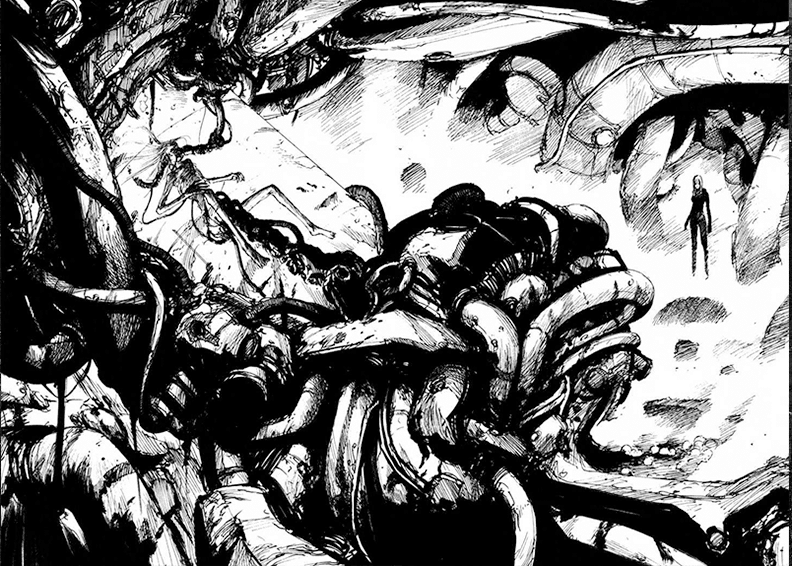
What’s interesting about Blame! is also the question of who the antagonists are. The more we learn about the world of Blame!, however, the more we discover that there are merely different factions opposing one another.
At first the Safeguard is the primary antagonist. We discover, however, that the Safeguard is merely a security network out of control which was originally responsible for protecting the Netsphere from unauthorized access.
The Silicon Life fits the term antagonists the closest, but even they are merely fending for survival in the City. It’s their goal to keep the current status quo, afraid that should humanity regain control over the City and the Safeguard, they’d be wiped out.
It’s even revealed in Blame² a sequel that the Silicon Life as Killy as ‘the calamity,’ the one responsible for their race almost going extinct.
The Governing Agency wants to find a Net Terminal Gen simply to stop the growth of the City and to regain control of it.
While we watch the story from the eyes of Killy, it appears, of course, that the Safeguard and the Silicon Life are the prime antagonists of the story. If we take a step back, however, we learn that all that’s happening is caused by mismanagement and the chaotic stage of the ever-expanding City.
Blame! – Visual Style
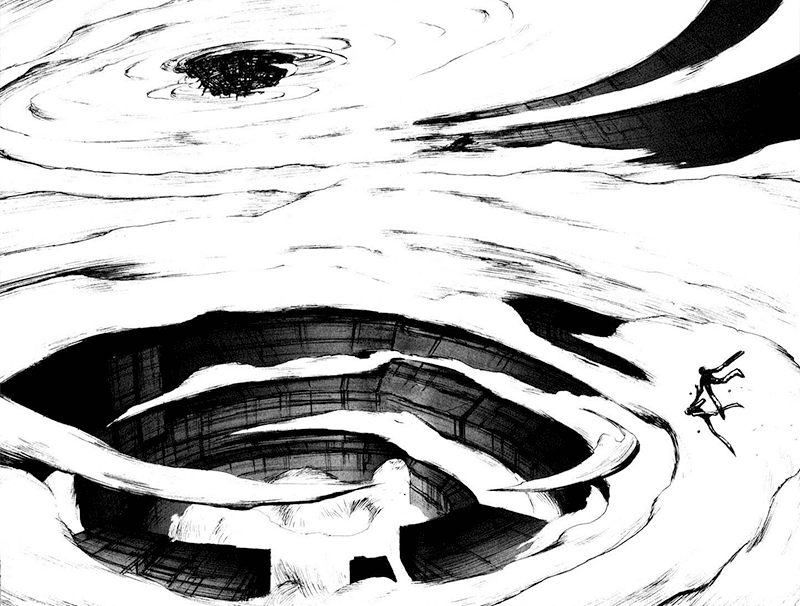
Blame! is one of the greatest manga’s I’ve ever read in terms of visuals. As mentioned before, I believe that Tsutomu Nihei is an artist who can rival the best in the genre. Be it his world or his various cybernetic horrors, Blame! is a marvel to look at.
Gigantic Proportions

The moment you start reading Blame! you realize that this manga’s different from others. Even in chapter 1, we already get to see the grand architecture of mind-boggling proportions so common to Blame!
You can clearly see that Tsutomu Nihei studied architecture and that he knows about the construction of buildings. It’s this knowledge that sets Blame! aside from other works.
There’s a sense of scale in many of Tsutomu Nihei’s panels that really showcases the insane proportions of the immeasurable City. Yet, all those constructions are as bleak as they are vast. Many times we can’t even make out the end of these constructions, as they seem to go on forever.
Many times, we see Killy in front of a backdrop of immeasurable proportions or we see him only as a small unimpressive dot as he walks vast metal plans, climbs giant buildings, or wanders a bridge that continues further than the eye can see.
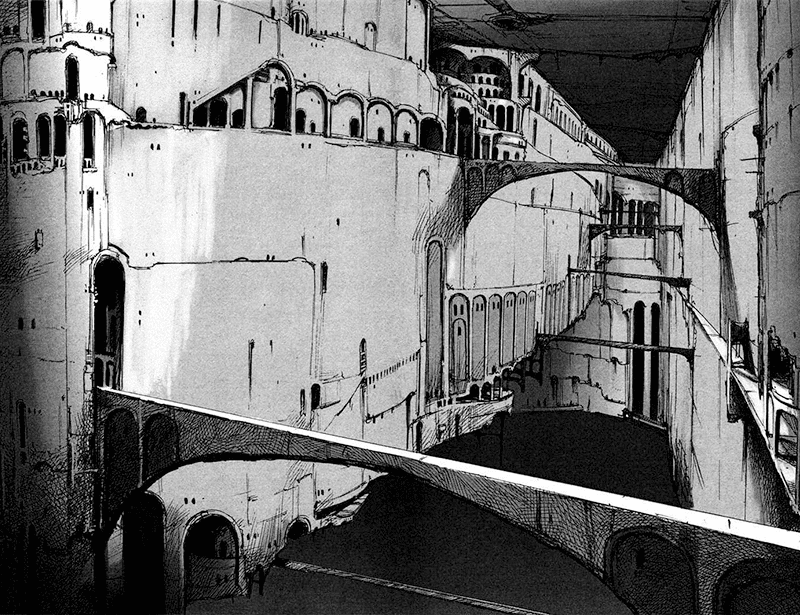
And yet, as gigantic as Tsutomu Nihei’s creations are, they are still insanely detailed. This attention to detail is especially prevalent when we get a closer look at the locations Killy travels. Technological gadgets, machines and many other elements of the City are rendered in stunningly beautiful detail.
It’s this mixture of mind-boggling proportions and attention to detail that truly brings forth Nihei’s world and truly immerses you in the story.
An interesting detail to note is that Blame!’s world isn’t a unified one. In one chapter, we see Killy traversing an amalgamation of high-tech constructions or a futuristic cityscape. In others, he’s ascending winding corridors, unending staircases or what looks like gothic castles. At times, these constructions look almost organic, almost like something that grew instead of being built.
Art, Colors and Shading

Tsutomu Nihei’s style is rough, almost dirty, especially in earlier chapters. His imagery comprises a lot of line work which lends itself fantastically to the more derelict and ruined areas of the City.
The many different details of the City are brought forth by a heavy reliance on shadows and shading.
Blame!’s entire visual style is one of the stark contrast between light and dark. Empty spaces are generally held in lighter colors while interiors, especially tunnels, caves and staircases, are conveyed via deep blacks.
What’s special about Tsutomu Nihei’s style is his usage of negative spaces to convey light or huge explosions during action sequences. This makes them a marvel to look at and helps to bring forth what’s happening.
Character Design
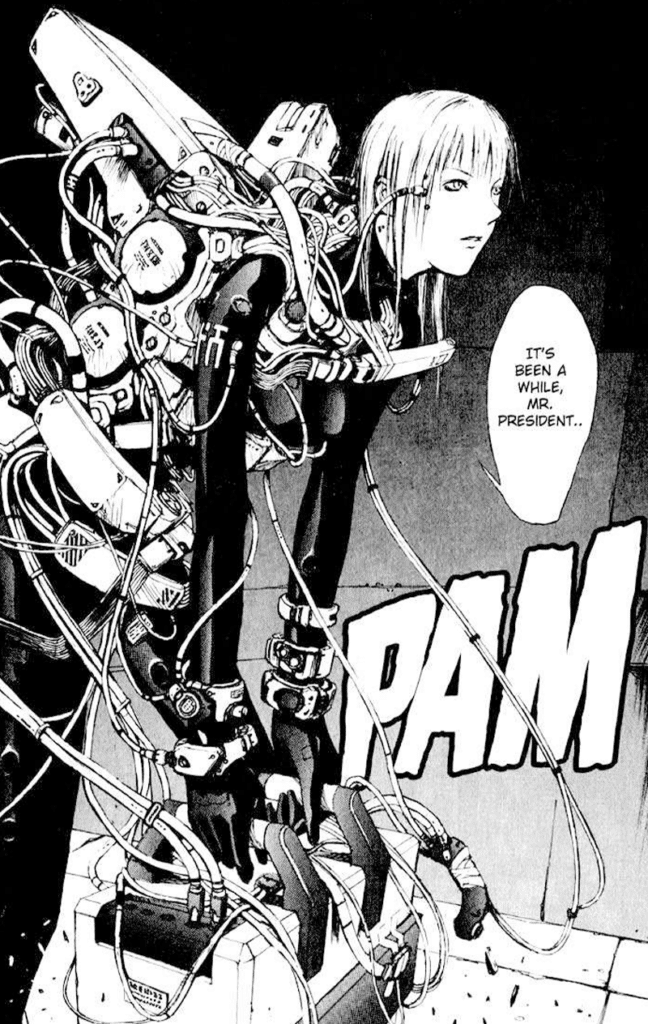
Killy’s design is an interesting choice. He’s wearing all back, no special armor and seems to be almost understated in a world as strange as Blame!’s. The same can be said about the rest of the cast, however. Cibo, Sanakan and also Dhomochevsky are all dressed similarly.
This is a stark contrast from the other inhabitants of the City who all have a distinctly different look from one another. The Electrofisher’s armor, the Silicon Life in general, but also the exterminators of the Safeguard.
Blame’s world is a harsh and dangerous one and as mentioned before, you can truly see it in the design of the many humans. Almost all of them look pale, sick, malnourished and depressed. They look hardened, emotionless and you can see just how much they went through.

What’s interesting to note is the aforementioned contrast of light and dark also applies to many of the character designs. The interior structure of the exterminators seems to be black, while their faces and outer parts are white. The same is true for the many Silicon Life, who generally have white, human faces, but distorted, black, metallic bodies.
One could even say that the color palette of a character shows their alignment. The most dangerous beings, like Schiff, or the armored Silicon Knights, are held entirely in black. Mensab and Sue, two arguably lawful individuals are held in almost pure white.
Our main characters, especially Killy, are almost all morally gray and thus are a mixture of black and white.
Cybernetic Horrors
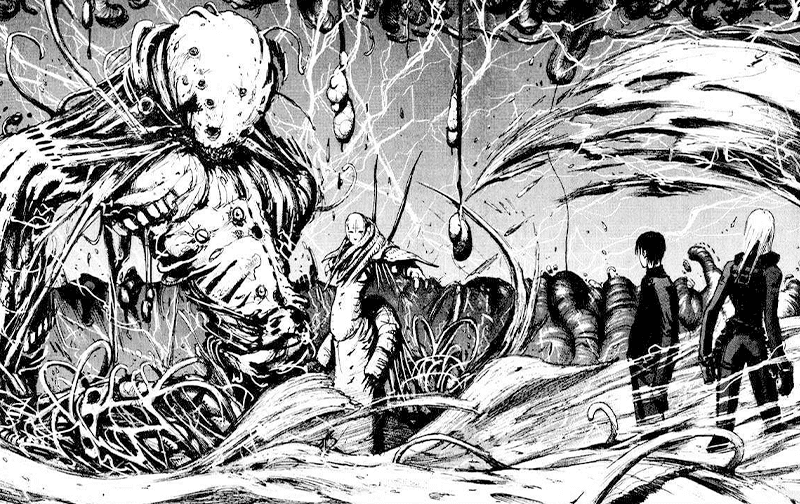
While Blame!’s world is one of futuristic high-tech, many of its elements look strangely biological.
This is especially true for the many cybernetic monstrosities Killy encounters, the exterminators of the Safeguard and the Silicon Life. They clearly look mechanical or robotic, but at the same time, they all have a distinctly organic look to them. This is especially true when new Safeguard units are synthesized. The entire process has a sort of biological look and feel to it.
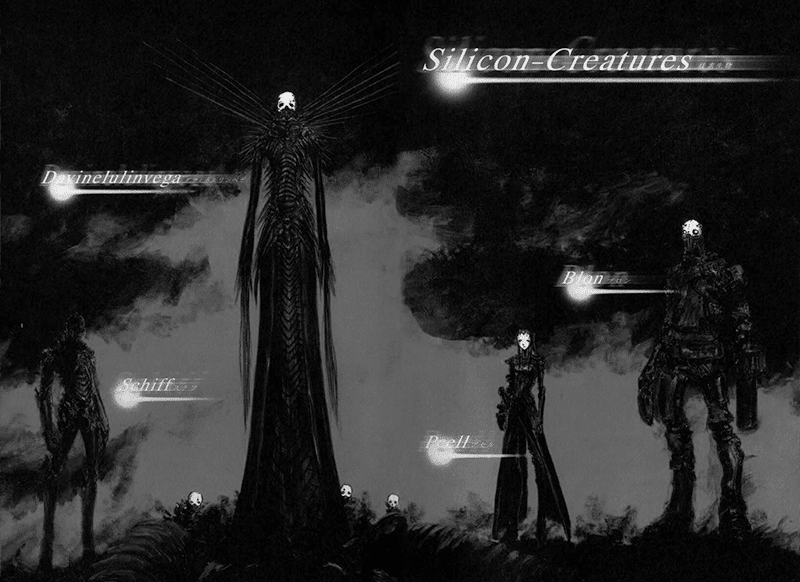
The many cybernetic horrors that populate the City are all fantastic, disturbing and outlandish to look at.
While the normal, level 1 exterminators look terrifying, they all look identical to one another and appear more like drones than anything else. Higher-level exterminators, however, look amazing. There’s the ‘siren’ Safeguard Killy encounters when climbing the tower, the high-level exterminator at the end of the story, but also Cibo after fusing with the level 9 Safeguard. They all have a distinct, almost angelic look to them with rings, haloes, and even wings. It’s an interesting design choice that only serves to make them creepier.
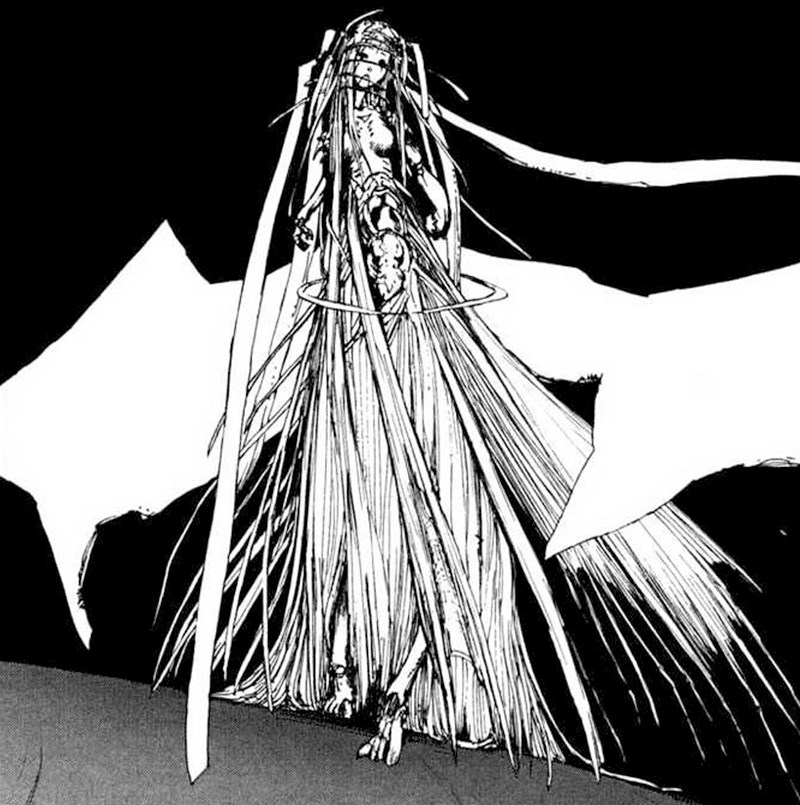
The Silicon Life has some of the most fantastic design I’ve ever seen in a science-fiction magna. They come in a variety of forms and design, employ a variety of weapons and wear a variety of armor. Some are even heavily distorted, sprouting additional limbs or parts.
Their design is throughout the book terrifying and disturbing, but they are a marvel to look at and are rendered in beautiful detail. Their design is reminiscent of the strange organic-inorganic art of H. R. Giger.
Action
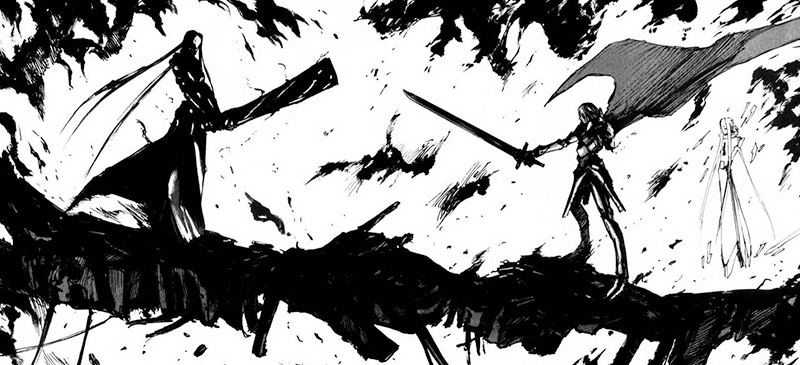
Blame! is full of frantic action which is always shown in stunning detail. Each of panel of it is fantastic to look at.
Many of the action sequences in Blame! are devastating, insane in scale and bright forth mass destruction. At other moments, however, they are more intimate and showcase fantastic close-range encounters.
There are also action scenes in Blame! that are clearly created for style alone. This is most prevalent in the Toha Heavy Industry arc, which features Seu, the protector of Mensab who appears as a knight in shining white armor wielding a sword. When he fights Ivy and when he fights the guards of the Central AI, it gives the action the air of a fantasy manga and not that of a science-fiction one. One thing has to be said, however, those fights look absolutely amazing!
Personal Thoughts and Why I love Blame!
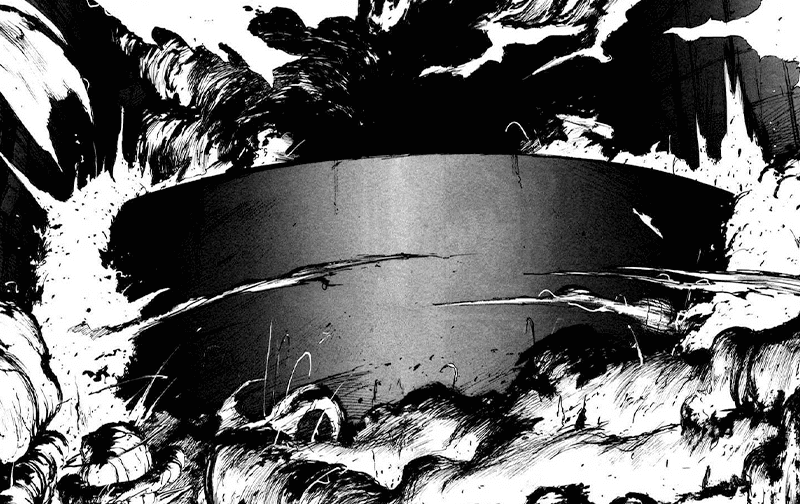
I always loved science-fiction, but especially the more futuristic and outlandish scenarios. Blame! was everything I was looking for.
It combines fantastic and unique world building with breathtakingly beautiful visuals. The art is incredible and shines because of its technical drawings and Tsutomu Nihei’s knowledge of architecture.
While Blame!’s setting is a post-apocalyptic dystopia, it’s one so strange and fresh it’s unique. It’s a tale of technology run amok which manifests in the ever-growing, chaotic City and the out-of-control Safeguard. Things go even so far as to include time travel, mass-scale teleportation and even parallel realities.
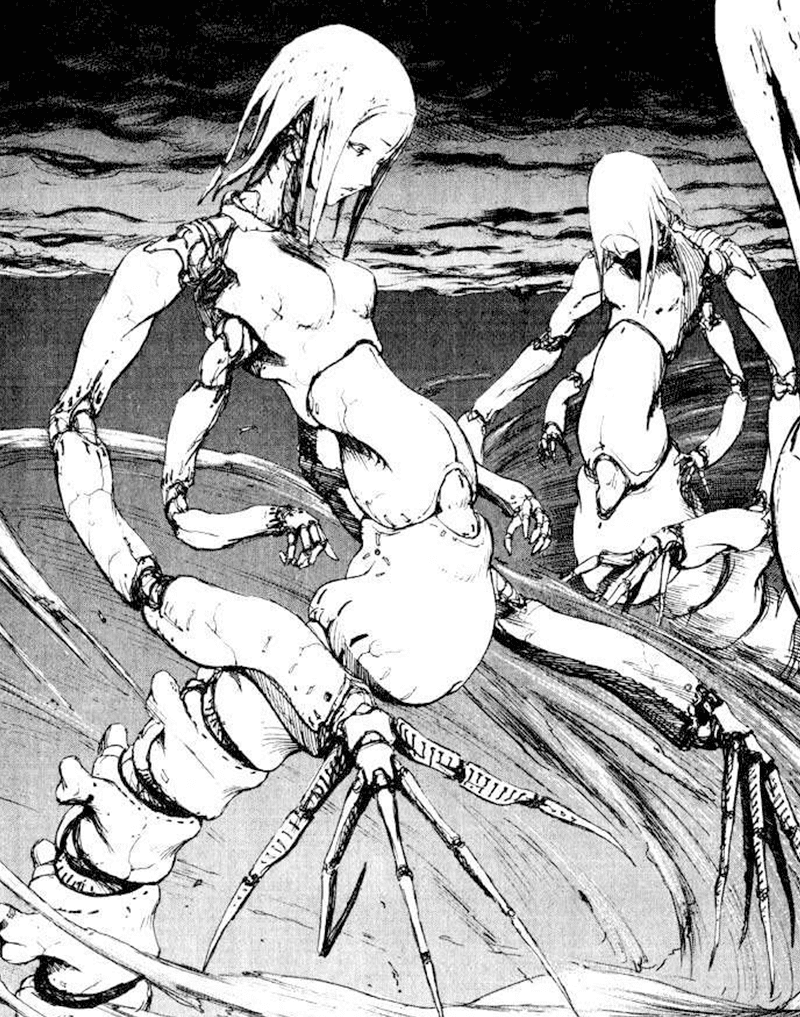
What I came to love the most, however, were the many creatures, especially the higher-level exterminators and the Silicon Life, who spice the manga up with a fair bit of horror because of their design and simply look gorgeous.
An interesting little detail is that Blame! never becomes preachy, never a discussion of the topics it showcases. Instead, it simply conjures up a nightmarish vision of our future, one unlike any ever seen before.
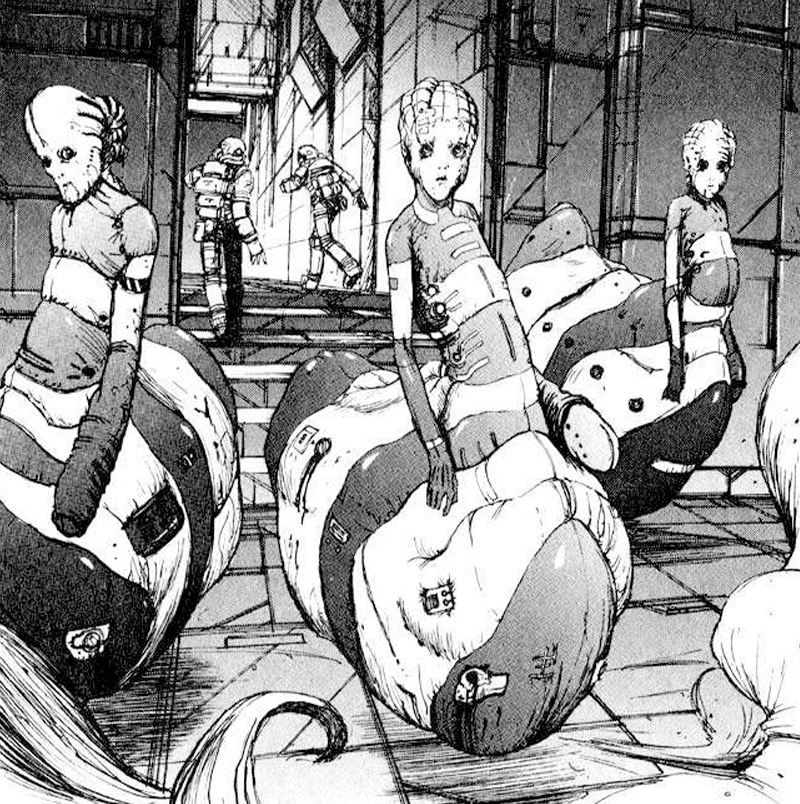
While most of Blame! is full of weird imagery, crazy action, and Killy’s stoic demeanor, there are some human and tender scenes. At one point, Killy and Cibo discover a cloning machine which is forever creating clones and which Killy promptly destroys. At another point, Killy saves a Dry Man child and later destroys the cooperation’s docks after he realizes that the transporter he was on was transporting Dry Man ready for organ harvesting.
Those minor events never detract from the atmosphere, but are instead merely there, but they help to flesh out Killy a bit and give him at least some semblance of emotion.
There are, however some problems with Blame! While I love the action scenes in the manga, some of them can be hard to follow because of the abundance of gigantic explosions caused by Killy’s Gravitational Beam Emitter.
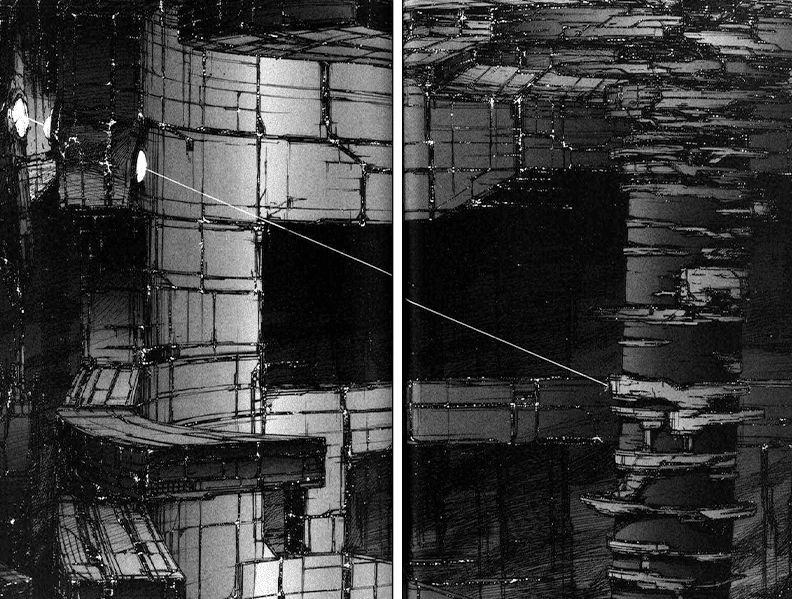
Another problem can be the style of story-telling and the story overall. It makes for a somewhat different, confusing reading and can be hard on first-time readers of the manga, making it almost necessary to read the manga more than once.
While I enjoyed the weird and outlandish technologies at play, I think Tsutomu Nihei went a bit too far during the Toha Heavy Industry arc and makes it one of the most confusing ones to follow and understand.
And yet, even with this criticism, I still think Blame! is an absolute visual masterpiece. It’s not something to be simply read, but it’s something to marvel at and to be immersed in.
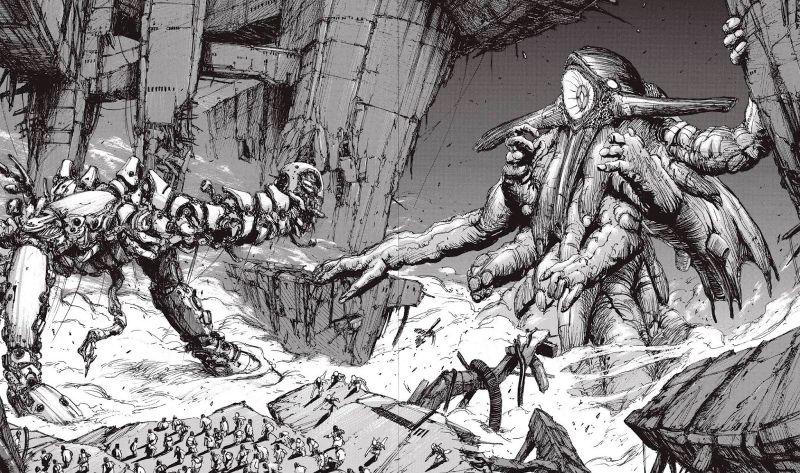
Blame! is a manga with an intensely dark and brooding atmosphere, a unique setting which is portrayed by vast, colossal structures and frantic action sequences.
I’d recommend Blame! to anyone interested in visual story-telling, people who are fans of science-fiction and anyone who loves cyberpunk.
If you want to read Blame!, I recommend buying the complete set of the Master Edition released by Vertical Comics:






